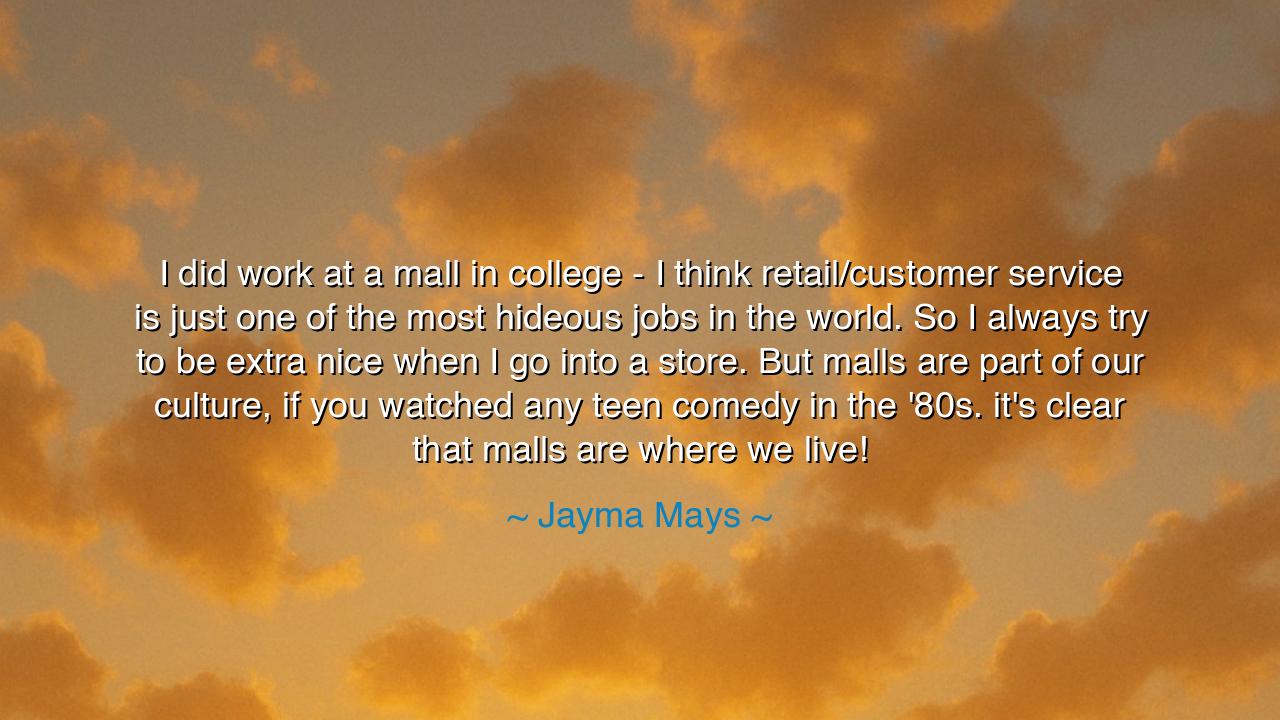
I did work at a mall in college - I think retail/customer
I did work at a mall in college - I think retail/customer service is just one of the most hideous jobs in the world. So I always try to be extra nice when I go into a store. But malls are part of our culture, if you watched any teen comedy in the '80s. it's clear that malls are where we live!






When Jayma Mays spoke the words, “I did work at a mall in college - I think retail/customer service is just one of the most hideous jobs in the world. So I always try to be extra nice when I go into a store. But malls are part of our culture, if you watched any teen comedy in the '80s. It's clear that malls are where we live!” she revealed both the burden and the beauty of a cultural institution. Her reflection is both complaint and confession: that retail work can be grueling, even demeaning, yet the mall itself holds an enduring place in the shared imagination, especially in the formative landscape of adolescence.
The origin of this statement rests in Mays’ own experience. As a young college student, she labored in the exhausting world of customer service, where patience is tested, dignity is often bruised, and the endless demands of strangers can weigh heavily on the spirit. From this hardship she learned compassion, vowing thereafter to treat all workers with kindness. Yet even as she critiques the job, she acknowledges the mall as a powerful symbol—a gathering place that defined youth culture, particularly in the 1980s, when it became the stage upon which countless teen comedies unfolded.
To understand her words, we must recall how the mall rose as a new temple of American life. No longer just a market, it became a meeting ground, a social hub, and for teenagers, a world apart from parents, schools, and rules. Movies such as Fast Times at Ridgemont High and Mallrats immortalized it, showing that the food courts, arcades, and glossy storefronts were more than commerce—they were the arenas of identity, romance, and rebellion. For the teen, the mall was a universe, echoing Johnson’s insight that each stage of life is serious to the one living it.
History too offers parallels. In ancient Athens, the agora was not merely a place of trade, but of culture, debate, and belonging. The Romans had their fora, where markets intertwined with politics and public life. In the same way, the mall became the modern agora of American youth—a place not just to buy, but to be, to perform identity, to encounter community. To say “malls are where we live” is to admit that culture often builds its sacred spaces in the most ordinary of places.
Yet Mays does not romanticize the labor behind the glamour. She reminds us that retail work is often “hideous,” a word heavy with truth. Those who serve in such places bear the unseen burdens of consumer culture—long hours, low pay, endless demands. Her vow to be “extra nice” in every store is not a small courtesy, but a recognition of the dignity of those whose labor supports the social fabric. In this dual vision, she honors both the worker and the cultural space that the mall represents.
The lesson here is twofold. First, let us be mindful of those who labor in the hidden places of culture, for their work is often unacknowledged yet essential. A kind word, a smile, or simple patience can be acts of mercy to those enduring the “hideous” burdens of service. Second, let us also recognize that culture is shaped not only in great halls of learning or politics, but in everyday spaces—malls, coffee shops, markets—where people gather, laugh, dream, and become themselves.
Practical wisdom flows: when you enter a store, remember to treat the worker not as a servant, but as a fellow traveler. When you pass through a mall or any public space, look deeper than its commercial facade; see it as a reflection of the long human story of gathering and belonging. And if you labor in such a place, know that even the most difficult work can leave behind lessons of compassion and resilience.
Thus let Jayma Mays’ words endure: the mall is both burden and symbol—burden for those who labor in it, symbol for those who grow within its walls. Treat its workers with kindness, and remember that the sacred can be found even in the food court, even under the neon lights, wherever people gather to live, to dream, and to be.






AAdministratorAdministrator
Welcome, honored guests. Please leave a comment, we will respond soon